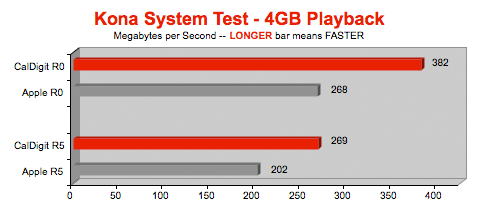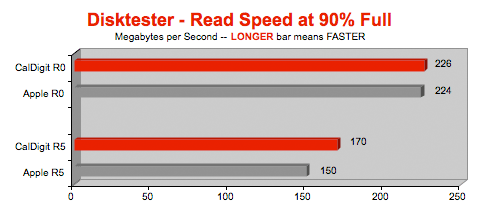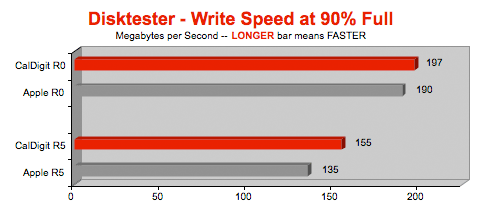TEST SCENARIO
We used the Kona System Test for empty RAID 0 and RAID 5 sets. We used Disktester to simulate a RAID 0 and 5 set that was almost filled (90%) to show how transfer speed slows when near capacity. This second test is what you need to consider when deciding how many drives you need to maintain your target transfer rate no matter how much data you've stored.




GRAPH LEGEND
CalDigit = CalDigit RAID card
Apple = Apple Pro RAID
R0 = RAID 0 (four internal 7K SATA drives)
R5 = RAID 5 (four internal 7K SATA drives)
Drives used were four Seagate Barracuda 7K 1TB 7200.11 Serial ATA units, which are among the RECOMMENDED DRIVES on CalDigit's list.
AND THE WINNER IS...
The CalDigit RAID card's maximum transfer rate is higher than the Apple Pro RAID, though the gap shrinks as you fill up the RAID set (See Disktester graphs). Though we tested four internal drives, the CalDigit RAID card distinquishes itself by support up to 12 external drives using three mini-SAS connectors.
KEY FEATURES
1. You can connect the factory Mac Pro mini-SAS connector to the CalDigit RAID card without the need for an adapter or extender.
2. It supports RAID 0, 1, 5, 6, 50, 60, and JBOD (more modes that the Apple Pro RAID card).
3. CaDigit has developed what they call Active Sustained Transfer Technology (ASTT) which optimizes the best transfer size and timing between the RAID controller cache and the host machine.
4. You can expand the size and level of the RAID set without having to reformat or lose data.*
5. It boots Mac OS X (as well as Windows and Linux). It also works with Boot Camp partitions.
6. Battery backup is an option.
7. Costs $250 less than the Apple Pro RAID without battery pack; $150 less with.
EXPANDING BEYOND FOUR DRIVES
CalDigit has a 4 bay enclosure, the HDElement, designed especially for the CalDigit RAID card, which enables you to use the three external mini-SAS connectors to expand the size of your RAID set as your needs grow. However, because the IOP333 Xscale I/O Processor is used in the RAID card, be advised that the maximum transfer rate is 500MB/s no matter how many drives you have. Then again, for applications like uncompressed HD video, that's more than fast enough.
GREAT GUI RAID MANAGER
We were very impressed by the Raid Shield, the RAID management utility that comes with the CalDigit RAID card. It's the best such utility we've used to date.
APPLE'S ONE ADVANTAGE
The one advantage the Apple Pro RAID card has over the CalDigit RAID card is support for SAS drives. CalDigit is gambling that the performance, price, and capacity of 7K SATA drives will make them the preference of the vast majority of Mac Pro users seeking a RAID solution.
We continue to be disappointed with the Apple RAID card performance compared to any of the third party alternatives, including the CalDigit RAID card. Charging $800 for a RAID card that hits the wall at 320MB/s no matter what drives you use? That's just crazy.